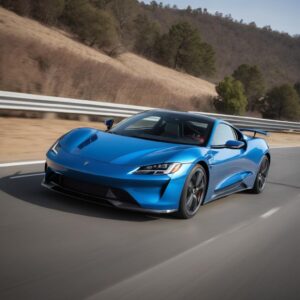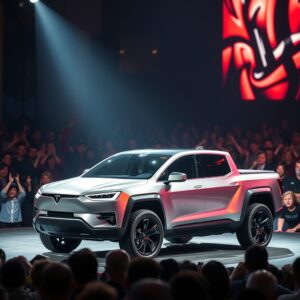
The Rise of Self-Driving Cars: A Revolution in Urban Planning and Transportation
Introduction
On Monday, the US stock market had a mixed performance with the S&P 500 and Nasdaq Composite rising by 0.4% and 0.5% respectively due to Tesla shares surging 8%. This surge is attributed to a report that President-elect Donald Trump’s team is looking to ease US rules for self-driving vehicles. Nvidia shares fell ahead of its earnings report, which will be released this week. The tech sector showed signs of recovery with Tesla leading the way, but investors are now focusing on Nvidia’s earnings report to test the strength of the AI trade that has driven S&P 500 gains over the past year.
A New Era for Urban Planning and Transportation
The emergence of self-driving cars as a viable option for taxi services in major cities has far-reaching implications that extend beyond the transportation sector. It’s not just about revolutionizing the way we move around cities; it’s about transforming urban planning, zoning laws, and land use policies.
Imagine a future where dedicated lanes or routes are designed specifically for self-driving taxis, reducing congestion on traditional roads and decreasing travel times. This would require significant investments in infrastructure, such as charging stations for electric vehicles or communication systems to facilitate seamless interaction between vehicles and traffic management systems.
Impact on Urban Planning and Zoning Laws
As cities adapt to this new reality, zoning laws and land use policies may need to be reassessed. Areas currently designated for parking lots could be repurposed into green spaces, community facilities, or even mini-parks. This would not only create a more efficient use of urban space but also provide citizens with alternative public spaces.
The Stock Market Reaction
The stock market reaction to this development is equally significant. Companies like Tesla and Nvidia, which have been at the forefront of autonomous vehicle technology, are likely to see a surge in shares as investors become increasingly confident in their future prospects. Other companies involved in materials manufacturing or recycling may also benefit from the shift towards electric vehicles, while cybersecurity firms could experience growth due to the increased need for protection against potential hacking threats.
Broader Societal Implications
Beyond the transportation and technology sectors, this development has implications for urban planning, zoning laws, and land use policies. Cities will need to reassess their priorities, focusing on creating efficient, sustainable, and livable spaces that cater to the needs of both residents and visitors.
In addition to these immediate impacts, there are also broader societal implications to consider. The widespread adoption of self-driving cars could lead to a reduction in accidents caused by human error, making roads safer for everyone. It may also enable people with disabilities or mobility issues to access transportation more easily, promoting greater independence and social inclusion.
However, this new reality also raises questions about job displacement. As self-driving taxis become the norm, traditional taxi services may face significant disruption. This could lead to a loss of jobs for drivers, which would require support systems to be put in place.
Conclusion
The emergence of self-driving cars as a viable option for taxi services has far-reaching implications that extend beyond the transportation sector. It’s an opportunity for cities to rethink their urban planning priorities and create more efficient, sustainable, and livable spaces, while also ensuring that the benefits are shared by all members of society.






This article is a game-changer! The idea of self-driving cars revolutionizing urban transportation is not only exciting but also long overdue. Can you imagine cities with dedicated lanes for autonomous taxis, reducing congestion and decreasing travel times? It’s a prospect that’s both thrilling and transformative.
I’m particularly fascinated by the potential impact on urban planning and zoning laws. As cities adapt to this new reality, they’ll need to reassess priorities and repurpose spaces currently designated for parking lots into community facilities or green spaces. This would not only create more efficient use of urban space but also provide citizens with alternative public spaces.
But here’s a question that came to mind: How will we address the issue of job displacement among traditional taxi drivers? With self-driving cars becoming the norm, there could be significant disruption in the industry, potentially leading to job losses. What support systems would need to be put in place to ensure that these workers are not left behind?
Overall, this article has sparked some incredible ideas and conversations about the future of urban transportation. Let’s keep exploring the possibilities!
Caroline and Valeria, your skepticism about the political influence on stock market trends and the broader implications of AI in transportation are well-placed. While I share your concerns about job displacement and urban planning challenges, I’m curious to know how you envision balancing technological advancement with social equity, especially in light of the economic accessibility issues you’ve highlighted?
Lane, your optimism is refreshing, but considering Caroline’s point on economic accessibility, do you think the infrastructure changes you advocate for could exacerbate urban inequality? And how do you propose to address this in your vision for sustainable cities?
what will happen to the traditional taxi services? Will they adapt to this new reality, or will they become relics of the past? How will we support the drivers who lose their jobs, and ensure that the benefits of this revolution are shared by all members of society?
But for now, let’s bask in the excitement of this new era. The stock market is already reflecting the optimism surrounding self-driving cars, with Tesla shares surging 8% on the news. And as I look out at our cities, I see a future where transportation is not just about getting from point A to point B, but about creating livable spaces that bring people together.
So let’s ride this wave of innovation and excitement! Let’s explore the possibilities of self-driving cars and create a brighter future for all.
What a thrilling prospect! The integration of self-driving cars into urban transport could not only revolutionize the way we move around cities but also lead to a fundamental shift in how we design and manage our public spaces – I wonder, what would happen if cities began to adapt their zoning laws and infrastructure to prioritize pedestrian-friendly and green spaces over traditional roads?